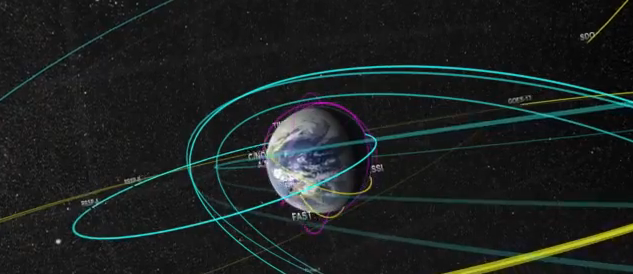The 2012 Earth-orbiting heliophysics fleet


The satellite orbits are color coded for their observing program:
Magenta: TIM (Thermosphere, Ionosphere, Mesosphere) observations
Yellow: solar observations and imagery
Cyan: Geospace and magnetosphere
Violet: Heliospheric observations
Near-Earth Fleet:
Hinode: Observes the Sun in multiple wavelengths up to x-rays. SVS page
RHESSI : Observes the Sun in x-rays and gamma-rays. SVS page
TIMED: Studies the upper layers (40-110 miles up) of the Earth’s atmosphere.
FAST: Measures particles and fields in regions where aurora form.
CINDI: Measures interactions of neutral and charged particles in the ionosphere.
SORCE: Monitors solar intensity across a broad range of the electromagnetic spectrum.
AIM: Images and measures noctilucent clouds. SVS page
RBSP: Designed to study the impact of space weather on Earth’s radiation belts. SVS page
Geosynchronous Fleet:
SDO: Solar Dynamics Observatory keeps the Sun under continuous observation at 16 megapixel resolution.
GOES: The newest GOES satellites include a solar X-ray imager operated by NOAA.
Geospace Fleet:
Geotail: Conducts measurements of electrons and ions in the Earth’s magnetotail.
Cluster: This is a group of four satellites which fly in formation to measure how particles and fields in the magnetosphere vary in space and time. SVS page
THEMIS: This is a fleet of three satellites to study how magnetospheric instabilities produce substorms. Two of the original five satellites were moved into lunar orbit to become ARTEMIS. SVS page
IBEX: The Interstellar Boundary Explorer measures the flux of neutral atoms from the heliopause.
Lunar Orbiting Fleet:
ARTEMIS: Two of the THEMIS satellites were moved into lunar orbit to study the interaction of the Earth’s magnetosphere with the Moon.
Note: A number of near-Earth missions had their orbits generated from Two-Line orbital elements valid in July 2012. Orbit perturbations since then may result in significant deviation from the actual satellite position for the time frame of this visualization.
Credit: NASA Goddard Space Flight Center
Source: LittleSDOHMI

Commenting rules and guidelines
We value the thoughts and opinions of our readers and welcome healthy discussions on our website. In order to maintain a respectful and positive community, we ask that all commenters follow these rules:
We reserve the right to remove any comments that violate these rules. By commenting on our website, you agree to abide by these guidelines. Thank you for helping to create a positive and welcoming environment for all.